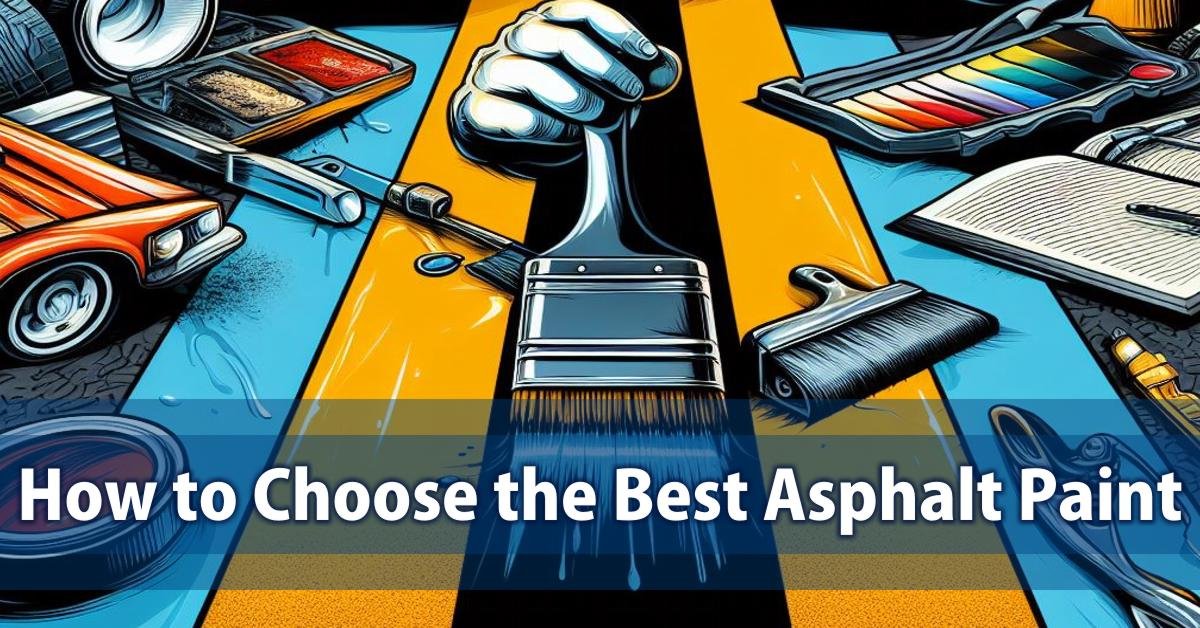Picking the right asphalt or striping paint for parking lots, driveways, and roadways involves understanding key differences in acrylic latex vs epoxy or urethane chemistry. With over 25+ years of expertise in road construction and pavement materials as a project manager, I’ve seen how proper product selection maximizes durability.
In this article, I’ll share my insights on matching high-performance paint types to specific uses and conditions.
I’m Steve Axton, and choosing quality paints that deliver lasting results even in tough environments has been a lifelong focus. Let’s explore how to choose the optimal asphalt paint or striping product to check all the boxes for your next project!
Matching Paint Chemistry to Specific Applications
Paints formulated for asphalt and concrete pavements utilize different resin technologies:
Acrylic Latex Paint
As a civil engineer and paving specialist with over 20 years of experience in high-performance asphalt materials and coatings, acrylic latex paints are a popular option we frequently use for appropriate applications. When selected and applied correctly, these economical water-based paints can deliver good longevity and aesthetics. However, their performance limits need to be recognized.
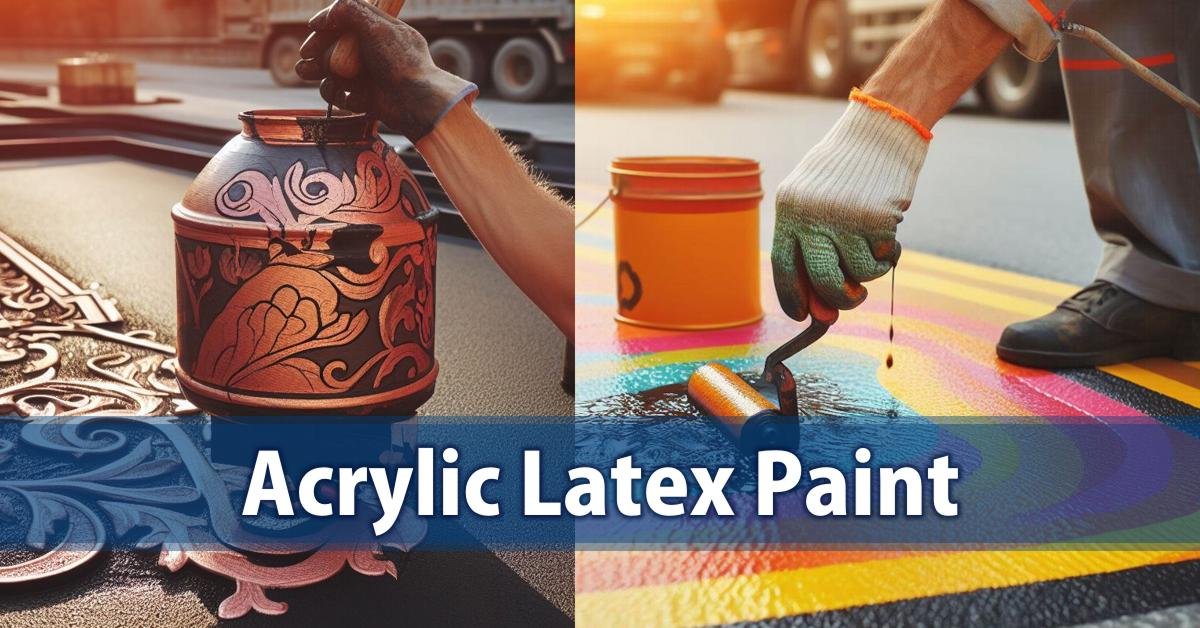
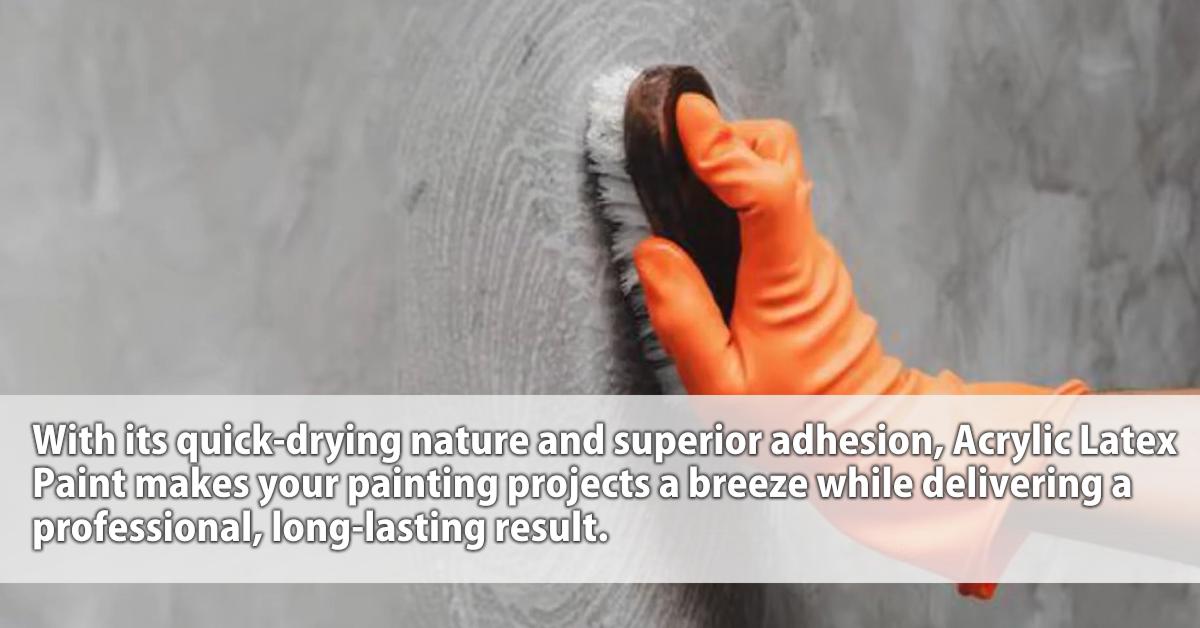
I’ve used acrylic latex paints on projects across the United States ranging from parking garages to airport taxiway markings. I share practical insights like when acrylics are the best solution for asphalt painting needs. Let’s take a detailed look at acrylic latex paint.
Acrylic Latex Paint Overview
Acrylic latex paints contain:
- Acrylic polymer particles suspended in water
- Pigments for color and hide
- Additives like coalescing agents and thickeners
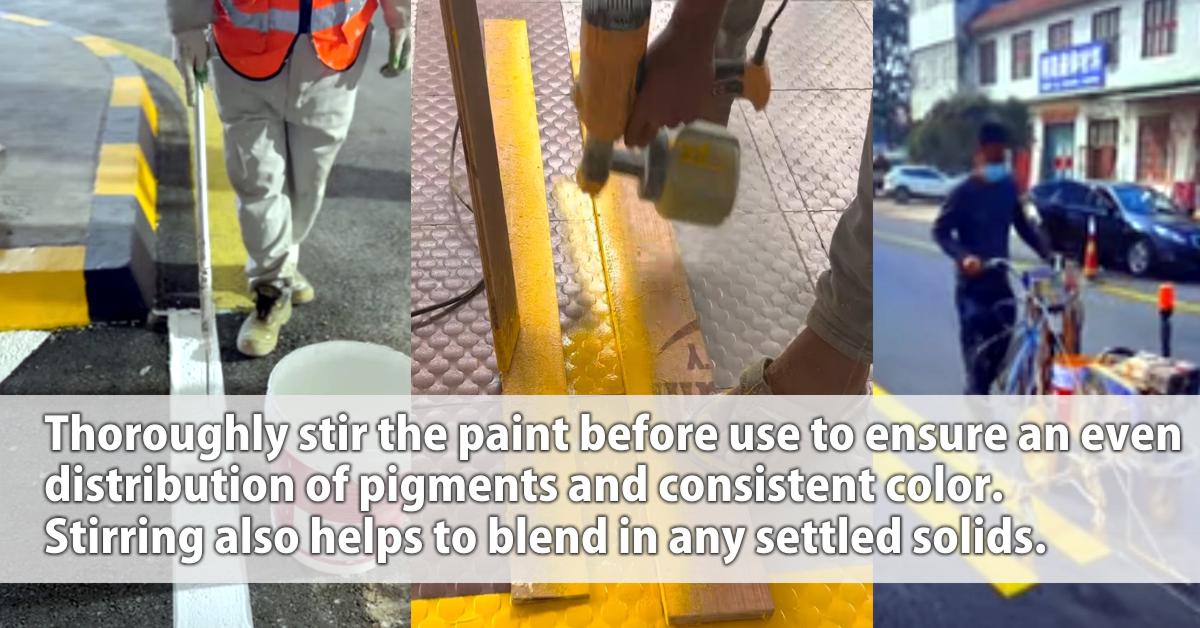
Unlike oil-based alkyds, acrylic latex paints are water soluble and contain minimal VOCs. Key traits include:
Pros
- Budget-friendly compared to other options
- Provide good color vibrancy and visual appeal
- Suitable for a variety of surfaces including aged asphalt and concrete
- Ideal for smaller-scale projects due to lower costs
Cons
- Less durable than epoxies or polyurethanes long-term
- Need reapplication every 1-4 years for continued performance
- More susceptible to wearing, fading, and chemical exposure than other paint types
Best Uses
- Residential driveways, home garages, patios, walkways
- Low to medium-traffic parking areas if routinely maintained
- Short-term, temporary striping or marking
Acrylics work well for small-scale, low-medium traffic paving projects where looks and budget takes priority over longevity. Their performance limits need recognition. For Residential driveways and home garages, Acrylic paint can be the best striping paint.
Learn when asphalt driveways can be effectively resurfaced.
Acrylic Latex Asphalt Paint Variations
While all utilize acrylic binders, some variations exist:
Straight Acrylics – Contain 100% acrylic polymer binders for maximum durability and UV resistance. Ideal for high-performance needs.
Vinyl Acrylics – Blended with vinyl or vinyl acetate binders for enhanced flexibility. Useful where adhesion concerns exist.
Staining Acrylics – Contain semi-transparent pigments that penetrate and protect against film formation. Develop patina over time.
Elastomeric Acrylics – Flexible rubbers added for crack resistance. Helpful for aged pavements.
Textured Acrylics – Embedded sand or grit creates a slip-resistant texture. Useful on community paths.
https://calculatorasphalt.com/asphalt-paving/
Acrylic Latex Asphalt Paint Types
| Type | Binder | Added Properties | Best Uses |
|---|---|---|---|
| Straight Acrylic | 100% Acrylic | Durability, UV resistance | High traffic areas |
| Vinyl Acrylic | Acrylic/Vinyl Blend | Adhesion, Flexibility | Low adhesion surfaces |
| Staining Acrylic | Acrylic + Penetrating Pigment | Patina effect | Beautifying aged asphalt |
| Elastomeric | Acrylic/Rubber Blend | Crack bridging | Distressed pavements |
| Textured | Acrylic + Grit | Skid resistance | Community trails, ramps |
Acrylic Latex Paint Considerations
To get the best results from acrylic latex pavement paints:
Surface Prep – Clean, abrade, and patch defects for good adhesion.
Primer – Consider a primer for aged or slick asphalt. Allows topcoat bonding.
Film Thickness – Two coats of 3-5 mils total dry thickness recommended. Thin coats lead to premature failure.
Application – Avoid painting in direct sunlight or low temperatures. Use quality brushes/rollers.
Dry Time – Cure a minimum of 24 hours before allowing vehicle traffic across painted areas.
Durability Expectations – Plan on reapplication every 1-4 years depending on usage, and climate exposure.
Maintenance – Address wear promptly. Acrylics allow inexpensive refresh coats.
Calculate asphalt tons needed for your paving project
Epoxy Paint
As an asphalt materials specialist for over 20 years, epoxy paints are one of the toughest, most durable coatings I turn to for heavy-traffic commercial projects demanding maximum chemical and abrasion resistance. However, their specific requirements like priming and precise mixing warrant awareness to achieve success.
I will provide practical insights on asphalt coatings like when epoxy paints are the best solution for severe service conditions. My past projects like factory floor re-painting have proven epoxy’s power when correctly selected and applied. Let’s explore epoxy paint in-depth.
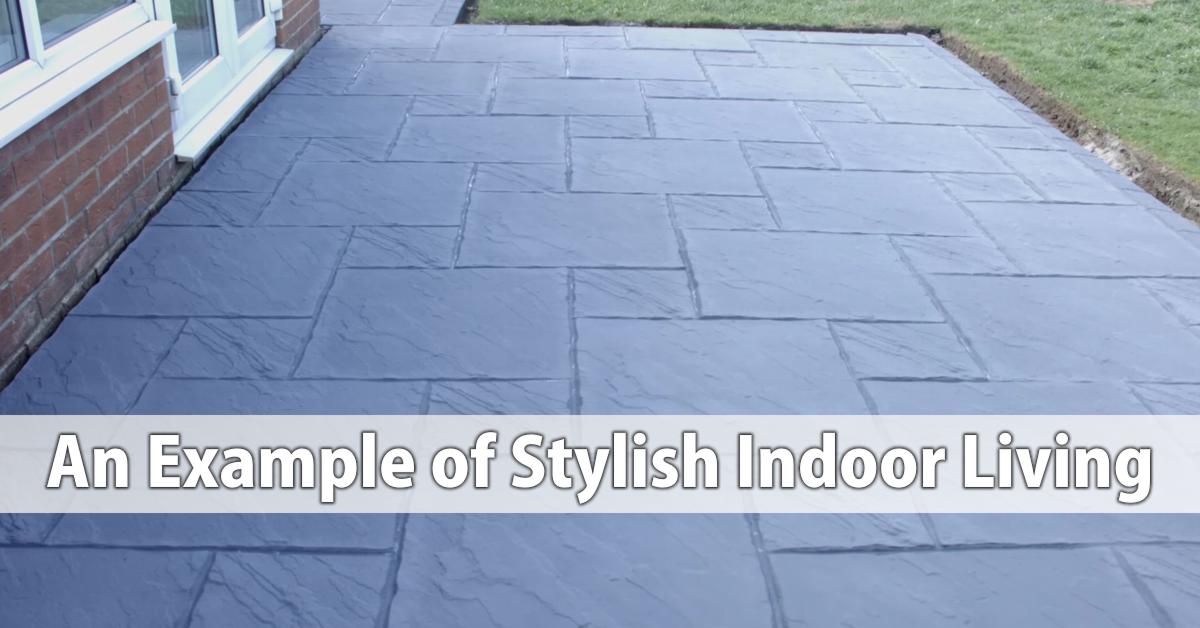
Epoxy Paint Overview
Epoxy paints utilize:
- Epoxy resins crosslinked with hardeners for superior strength.
- Industrial pigments for color and hide.
- Added agents to influence flow, adhesion, and UV resistance.
Key traits of quality epoxy paint:
Pros
- Extreme chemical, abrasion, and corrosion resistance
- Strong adhesion to prepare substrates
- Excellent hot tire pickup and wearing resistance
- Long-term color and gloss retention
Cons
- Higher cost than water-based coatings
- Priming often required before the application
- Precise mixing and application techniques needed
- Limited application temperature range
Best Uses
- High-traffic parking decks, ramps, commercial floors
- Aircraft hangars, maintenance areas
- Industrial shop and warehouse floors
Epoxy paints excel in severe service conditions but require adherence to application specifications for success. For High traffic and Parking decks, Epoxy paint is the best asphalt paint.
Discover how long asphalt takes to fully cure and dry
Table 1. Types of Epoxy Paint
| Type | Description | Key Traits | Uses |
|---|---|---|---|
| Standard | Pure epoxy resins | Toughness, chemical resistance | Floors, high-wear areas |
| Fast Cure | Quick hardening epoxies | Fast return to service | Minimize downtime |
| High Solids | Low VOC, high film build | Thickness, efficiency | Comply with VOC regulations |
| Color-Stable | Enhanced pigments | Max. UV stability | Exterior applications |
| Cold Cure | Cure down to 35°F | Year-round application | Seasonal flexibility |
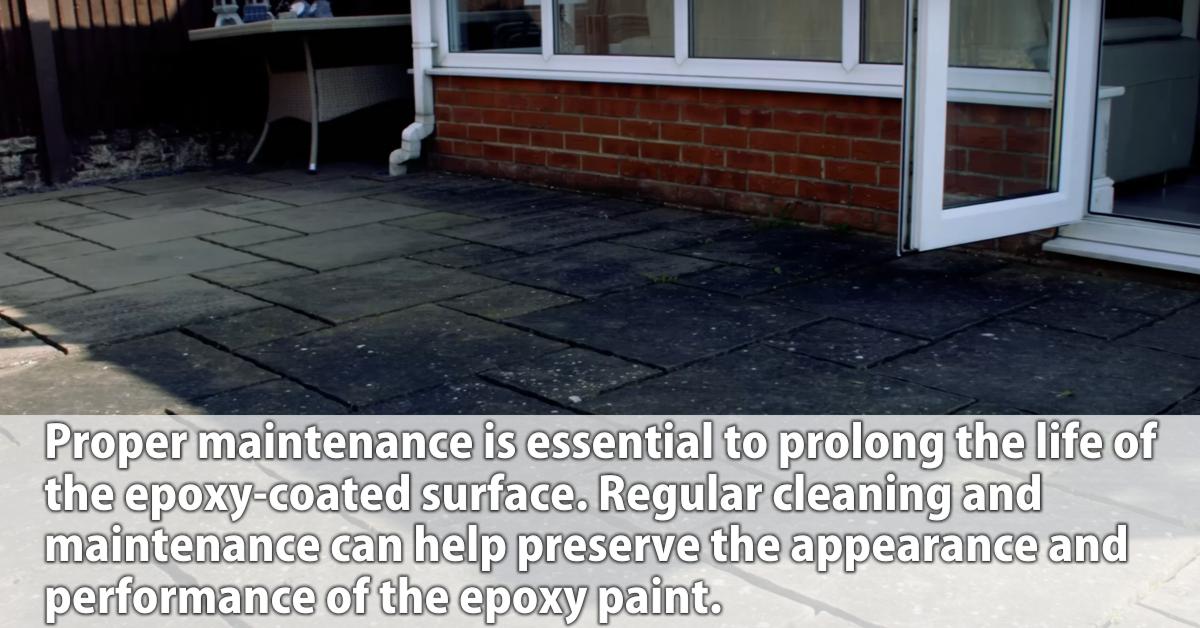
Considerations for Quality Epoxy Paint Jobs
To achieve excellent results with epoxy floor or pavement paint:
Surface Preparation – Shotblast or acid etch concrete. Clean and abrade asphalt very thoroughly. Prime if needed.
Mixing – Precisely follow instructions, carefully pre-mix each component before combining.
Thinning/Reducing – Only thin if expressly allowed by the manufacturer and with their approved thinner.
Application – Apply in 50-70°F temps using quality roller naps or airless tips. Avoid drips and sags.
Recoat Time – Adhere strictly to recoat windows to ensure inter-coat adhesion. Don’t rush!
Film Thickness – Apply two coats to achieve 8-12 mil total dry thickness for durability.
Cure Time – Allow 1-week minimum for full cure before chemical or heavy traffic exposure.
Clean Up – Immediately clean all equipment with an approved solvent like xylene per the product’s guidance.
Polyurethane Paint
With over 20 years of expertise in pavement coatings and materials, polyurethane paints are my top recommendation for extremely demanding environments thanks to their unmatched durability and flexibility. However, their premium cost means reserving them for heavy-duty needs where no other coating can survive.
I’m Steve Axton, and I run CalculatorAsphalt.com to provide real-world guidance on asphalt paints and when products like polyurethanes are worth the investment. My past projects on major roadways and high-traffic sites have proven polyurethane’s value for long-term performance. Let’s take an in-depth look at polyurethane paint.
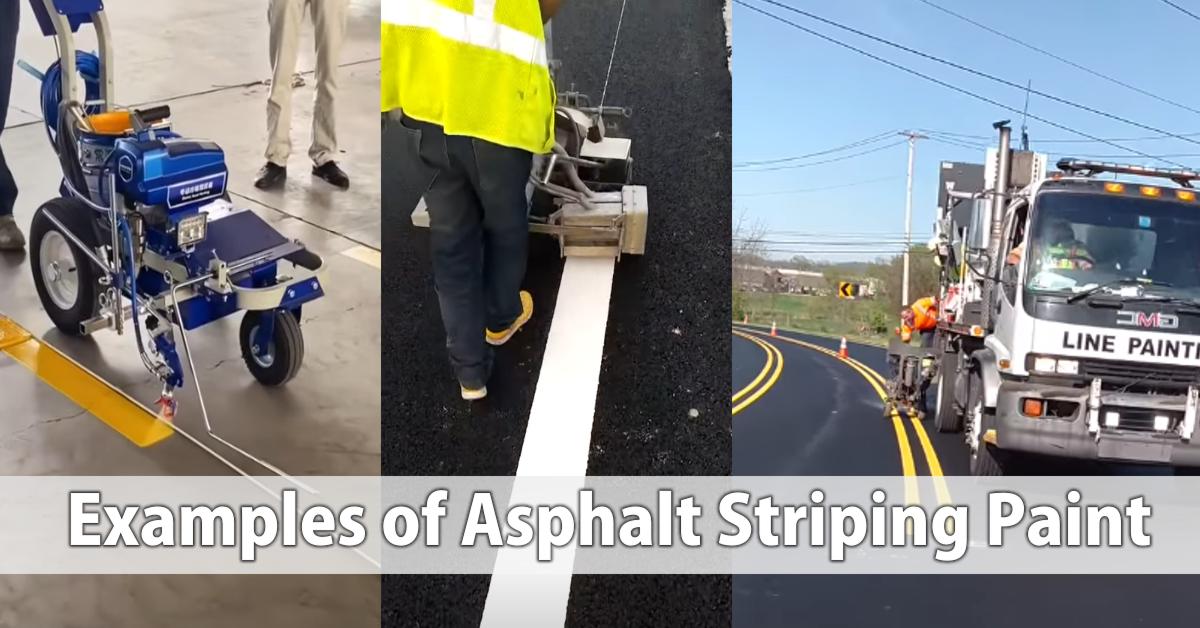
Understand causes of asphalt deterioration and failure
Polyurethane Paint Overview
Polyurethane paints contain:
- Isocyanate-cured urethane polymers for superior toughness and flexibility
- Industrial pigments for color and hide
- Agents to resist chemicals, abrasion, and UV degradation
Key attributes of quality polyurethane paint:
Pros
- Extremely long service life span – up to 10+ years
- Unmatched resistance to wear, chemicals, UV light
- Excellent adhesion to asphalt and concrete without priming
- Fast drying and cure times in many formulations
Cons
- More costly than other paint options upfront
- Typically applied by experienced professionals
- Paint materials have short shelf stability once activated
Best Uses
- High-traffic roadways, intersections, pedestrian crossings
- Commercial parking areas with constant abuse
- Aircraft taxiways, ramps, and other pavements
Polyurethane paints deliver unmatched longevity under severe service conditions to minimize life cycle costs. So, Polyurethane paint can be the best asphalt paint.
Table 1. Polyurethane Pavement Paint Types
| Type | Description | Key Properties | Uses |
|---|---|---|---|
| Aromatic | Pure urethane resins | Chemical resistance | Truck yards, fueling areas |
| Aliphatic | UV stabilizers added | Enhanced light stability | Road striping, markings |
| Moisture Cured | Reacts with humidity | Faster curing | Cooler, damp climates |
| Two Component | Separate resin & catalyst | Precise curing control | Wide temperature use |
Polyurethane Paint Considerations
Points to weigh when selecting and applying polyurethane paint:
- Perform thorough surface preparation for clean, abraded, dry surfaces.
- Carefully follow instructions for any mixing of multi-component products.
- Apply in 50-90°F temps using the quality airless sprayer and backroll/tip.
- Adhere to recoat windows between layers for proper inter-coat adhesion.
- Build to 10-15+ mil total dry film thickness for maximum durability.
- Allow 72 hours cure before chemical exposure; and 7 days before vehicle traffic.
- Meticulously clean spray equipment immediately after use to avoid damage.
While costly, polyurethane paints provide a wise long-term investment given their exceptional service life of 10 years or more.
Reflective Paint for Asphalt Striping
The safety of our roads and parking lots, particularly during the nighttime, is a top priority for both drivers and pedestrians. Reflective paint for asphalt striping plays a pivotal role in enhancing visibility and safety during low-light conditions.
Characteristics of Reflective Paint:
Reflective paint is specifically formulated to provide excellent visibility at night. Its key characteristics make it a standout choice for enhancing safety on the roads.
Designed for Enhanced Visibility at Night:
Reflective paint is engineered to ensure that road markings and signs remain visible even when natural light is limited. This characteristic is essential for guiding drivers and pedestrians in the dark, reducing the risk of accidents.
Contains Reflective Glass Beads or Microprismatic Materials:
Reflective paint achieves its nighttime visibility through the use of reflective elements. These elements, often in the form of glass beads or microprismatic materials, bounce light back toward its source, making road markings and signage stand out in the dark.
Various Base Paint Types Can Be Reflective:
Reflective technology can be incorporated into different types of base paints, allowing for versatility in applications. Whether you prefer water-based or oil-based paints, reflective paint can be adapted to suit your needs.
Ideal Applications of Reflective Paint:
The versatility of reflective paint extends to various applications, all of which contribute to safer nighttime experiences on our roads and in parking areas.
Road Lane Markings:
Reflective paint is commonly used for lane markings on highways and city roads. Its ability to reflect headlights makes lane divisions clearly visible to drivers, aiding in safe lane changes and traffic flow.
Highway Signage:
Reflective paint is also used for highway signage. Whether it’s exit signs, speed limits, or directional signs, the reflective properties ensure that vital information is readily visible to drivers, even in the dark.
Parking Lot Directional Markings:
Navigating a parking lot during the night can be challenging without proper lighting. Reflective paint on directional markings and parking spaces guides drivers, reducing confusion and potential accidents.
Matching Paint to Specific Uses
Selecting the optimal asphalt paint for specific uses requires carefully evaluating key factors like traffic, exposure conditions, surfaces, dry times, and lifecycle costs.
Choosing the right pavement coating comes down to aligning needs with product performance attributes. As an experienced coatings engineer, I always assess considerations like traffic volume, chemical exposure risks, required dry times, and overall lifecycle value when recommending asphalt paints.
I’m Steve Axton – on my website CalculatorAsphalt.com I provide real-world guidance on selecting optimal asphalt paints like which products make the most sense for particular applications. Having specified coatings for demanding projects across the country, and matching available paint chemistries to needs is vital for success.
Traffic Volume
Heavier traffic volumes require increasingly durable paints:
Acrylic Latex – Only suitable for very low-traffic residential situations once cured. Too soft for frequent abrasion.
Epoxy – Withstands regular heavy vehicle traffic. Used on manufacturing floors, and commercial sites.
Polyurethane – The toughest, able to survive the highest traffic roadways and abusive conditions over time.
Table 1. Paint Selection by Traffic Volume
| Traffic Level | Paint Recommendation |
|---|---|
| Very Low | Acrylic Latex |
| Moderate | Epoxy |
| High | Polyurethane |
| Severe/Extreme | Polyurethane |
Higher-performing paints like polyurethanes cost more but provide the best long-term value under constant traffic.
Exposure Level
If subjected to corrosive influences, upgrade to more resistant epoxy or polyurethane paints:
Deicing Salts – Polyurethane or epoxy paint withstands chloride salts without blistering or peeling. Acrylics fail quickly.
Automotive Fluids – Epoxy and polyurethane offer good chemical resistance versus acrylics. Fueling areas need such protection.
UV Radiation – Epoxy and polyurethane paints retain color and gloss much longer than acrylic options in exterior applications.
Abrasion – Polyurethanes highest abrasion resistance, followed by epoxies. Acrylics abrade relatively quickly.
Paint Selection by Exposure
| Exposure | Paint Recommendation |
|---|---|
| Normal | Acrylic Latex |
| Deicing Salts | Epoxy or Polyurethane |
| Automotive Fluids | Epoxy or Polyurethane |
| Exterior UV | Epoxy or Polyurethane |
| High Abrasion | Polyurethane |
Again, paying more for epoxy or polyurethane durability saves on replacement costs long-term.
Application Surface
Certain paints adhere better to different pavement surfaces:
- Acrylic latex is applied directly to asphalt or concrete.
- Epoxy needs a primer before application to asphalt. Adheres well to concrete.
- Polyurethane bonds tenaciously to either concrete or asphalt without primer.
Paint Adhesion by Substrate
| Paint | Asphalt | Concrete |
|---|---|---|
| Acrylic Latex | Direct | Direct |
| Epoxy | Primer Needed | Direct |
| Polyurethane | Direct | Direct |
Verify the recommended surface preparation for the paint and substrate combination being used.
Fast Dry Requirements
For marking or floors needing rapid return to service, fast-drying paint options exist:
- Standard acrylic latex dries in 30-60 minutes for foot traffic.
- Fast-dry acrylic latex allows traffic in 30 minutes.
- High solids epoxies can be walked on in 2 hours.
- Fast-cure polyurethanes are driveable in 1-3 hours.
Table 4. Dry Time by Paint Type
| Paint | Dry Time |
|---|---|
| Standard Acrylic | 30-60 Minutes |
| Fast Dry Acrylic | 15-30 Minutes |
| High Solids Epoxy | 1-2 Hours |
| Fast Cure Polyurethane | 1-3 Hours |
Evaluate needs to ensure paint dries quickly enough for operational schedules.
Lifecycle Cost Analysis
Considering long-term costs over continual recoating favors durable options:
- Acrylic latex needs redoing yearly in heavy traffic areas at ~$0.10-0.15/ft2.
- Epoxy coatings lasting 5+ years cost ~$0.35-0.50/ft2.
- Polyurethanes lasting 7-10+ years run ~$0.75-1.00/ft2.
Spending more upfront on epoxy or polyurethane pays dividends over time through fewer redos and closures. Carefully weighing key considerations against product attributes ensures the optimal asphalt paint selection for specific needs and maximum value. My coatings expertise helps simplify product choice.
Comparing Key Asphalt Paint Options
Let’s outline the pros and cons of top options specifically for asphalt:
Asphalt Acrylics
Pros – Budget-friendly, good looks, easy application.
Cons – Less durable, needs frequent recoating, limited chemical resistance.
Best For – Low-traffic residential uses if maintained diligently.
Epoxy Asphalt Paint
Pros – Tough, chemical resistant, long-lasting.
Cons – Requires priming, tricky application, expensive.
Best For – High-traffic areas wanting maximum durability.
Polyurethane Asphalt Paint
Pros – Unmatched durability, no priming needed, fast drying.
Cons – Premium cost, spray application recommended.
Best For – Heavy-duty traffic areas to extend repaint cycles.
Selecting the right solution comes down to aligning needs with performance.
| Criteria | Asphalt Acrylics | Epoxy Asphalt Paint | Polyurethane Asphalt Paint |
|---|---|---|---|
| Pros | Budget-friendly, Good looks, Easy application | Tough, Chemical resistant, Long-lasting | Unmatched durability, No priming needed, Fast drying |
| Cons | Less durable, Needs frequent recoating, Limited chemical resistance | Requires priming, Tricky application, Expensive | Premium cost, Spray application recommended |
| Best For | Low-traffic residential uses if maintained diligently | High-traffic areas wanting maximum durability | Heavy-duty traffic areas to extend repaint cycles |
Applying Asphalt Paint Successfully
Once the right asphalt paint is chosen, proper application ensures results:
Surface Preparation
- Clean and degrease surfaces thoroughly before painting.
- Patch cracks or spalls and profile the area.
- Abrade slick or glossy coatings.
- Apply primer if recommended by the manufacturer.
Mixing and Thinning
- Mix paints to a uniform consistency without clumps if multi-component.
- Only thin water-based acrylics sparingly with water if needed for spraying.
Application Method
- Use a quality brush, roller, or airless equipment sized appropriately.
- Lay down smooth, consistent coats without heavy brush strokes.
- Spread at coverage rates per manufacturer directions.
Dry Time and Overcoating
- Allow proper dry time between coats as specified by the product. Rushing causes failure.
- Lightly sand or abrade between coats for optimal adhesion.
- Apply two or more coats for best durability and hide.
Cleanup and Safety
- Clean equipment like sprayers promptly to avoid damage.
- Follow all safety precautions listed for the product.
Proper application workflow ensures the paint performs as intended over the long run.
Key Considerations for Asphalt Striping Paint
Specifying high-performance striping paint for asphalt requires evaluating several key properties beyond basic paint chemistry. As an experienced coatings engineer, I carefully assess attributes like pigmentation, adhesion, cure times, and wet weather durability when selecting durable pavement marking paints.
I’m Steve Axton – on my website CalculatorAsphalt.com, I offer real-world tips on choosing optimal asphalt striping paints for long-lasting visibility and performance. Having specified marking paints for busy highways and airports, and understanding these critical traits is essential for success.
Pigmentation Levels
Higher pigment loading increases opacity, durability, and weather resistance:
- Pigments like titanium dioxide provide color, reflectivity, and hide.
- Paints with 20-30%+ pigment content by weight perform better.
- More pigment also boosts UV, chemical, and abrasion resistance.
- Check product data sheets for pigment levels as an evaluation metric.
Table 1. Comparing Paint Pigment Content
| Paint Type | Typical Pigment Content |
|---|---|
| Standard Acrylic | 15-25% |
| Heavy Bodied Acrylic | 20-30% |
| Epoxy | 25-35% |
| Polyurethane | 25-40% |
Heavier pigmented paints last markedly longer through improved weathering properties and durability.
Adhesion Properties
Excellent adhesion to asphalt is needed without separate primer:
- Paints should form a strong chemical and mechanical bond to the substrate.
- Priming asphalt adds unwanted cost, time, and variability.
- Check product data for specifics on asphalt adhesion properties without priming.
- Field test potential paints for coating integrity through scrape/scratch adhesion checks.
Table 2. Comparing Asphalt Adhesion
| Paint Type | Typical Adhesion to Asphalt |
|---|---|
| Standard Acrylic | Moderate |
| Heavy Bodied Acrylic | Very Good |
| Epoxy | Primer Often Needed |
| Polyurethane | Excellent |
Top coating integrity and adhesion minimize the potential for delamination or lifting over time.
Dry and Cure Times
Faster paint drying and curing allows earlier restoration of traffic:
- Standard paints may require 30-90 minute dry times before reopening lanes.
- Enhanced “fast dry” paint technologies can be opened in 5-15 minutes.
- Faster return to service improves work zone safety and minimizes impacts.
- Check product data for actual dry and cure times before specifying.
Table 3. Typical Dry Times by Paint Type
| Paint Type | Dry Time Range |
|---|---|
| Standard Acrylic | 30-90 Minutes |
| Fast Dry Acrylic | 5-15 Minutes |
| Epoxy | 2-4 Hours |
| Fast Cure Polyurethane | 15 Minutes-2 Hours |
Selecting paints that restore traffic flow quickly improves safety and public mobility.
Reflectivity and Visibility
Glass beads in the paint provide critical nighttime reflectivity:
- Beads refract headlight beams back to the driver for improved visibility.
- Typical bead loading rates range from 15-30% by weight in pavement marking paint.
- Bead density, gradation, and embedment level all influence reflectivity.
- Ensure bead quality conforms to DOT specifications like AASHTO M247.
Table 4. Reflectivity Factors for Striping Paints
| Factor | Description |
|---|---|
| Bead Density | Higher density improves reflectivity |
| Bead Gradation | Mix of bead sizes enhances reflectance |
| Embedment | Optimal submersion but not engulfing |
| Coating Durability | Maintains bead surface exposure |
Proper bead selection, loading, and application ensure maximum nighttime striping reflectivity and visibility.
Wet Weather Durability
Some striping loses color and contrast when wet:
- Dark asphalt appears through the coating when water saturates the film.
- Quality paints maintain color even when wet for improved visibility.
- Request lab data on wet retro-reflectivity per ASTM E2177. Higher values perform better.
- Check product wet weather durability specifications before selecting.
Table 5. Comparing Wet Reflectivity
| Paint Type | Typical Wet Reflectivity |
|---|---|
| Standard Acrylic | Moderate loss |
| Epoxy | Good retention |
| Polyurethane | Excellent retention |
Wet weather durable paints remain clearly visible even during rainy conditions for improved safety.
Carefully evaluating key paint traits like these ensures optimal asphalt striping integrity, reflectivity, and longevity in the field. My coatings expertise helps simplify specifications.
Following the same surface prep, application, and care processes previously covered ensures paint lines resist wear, weathering, and abuse as intended.
Picking and Applying Asphalt Paints for Fast Return to Service in 24 Hours
As an experienced coatings engineer, I’m often asked – what asphalt paints can be applied and cured to allow traffic back on the surface in less than 24 hours. With the right products, even heavily trafficked areas can be recoated overnight. Let’s compare fast-dry paint options for rapid return to service.
Comparing Asphalt Paint Dry Times
Standard latex acrylic paints require overnight drying before light traffic:
Table 1. Standard Asphalt Paint Drying Time
| Paint Type | Dry Time | Traffic |
|---|---|---|
| Standard Acrylic | 8-12 Hours | Next Day |
Specialized fast-dry acrylic formulations shorten the timeline:
Table 2. Fast Dry Acrylic Asphalt Paint
| Paint Type | Dry Time | Traffic |
|---|---|---|
| Fast Dry Acrylic | 1-3 Hours | Same Day |
Enhanced Drying Technologies
Fast-dry paints utilize:
- Special polymer emulsions that coalesce and cure rapidly once applied.
- Added coalescing solvents that quickly evaporate from the film.
- Unique rheology modifiers for quick leveling without sagging.
Matching Paint to Dry Time Needs
Consider fast-dry paints when:
- Traffic impacts must be minimized for high-use areas.
- Overnight closure is impossible at facilities operating 24/7.
- Accelerated staging is needed to meet tight schedules.
While costing more, fast-dry paints can pay dividends through improved uptime and flexibility. Discuss options with your coatings supplier to match products to your unique operational needs and constraints.
Proper Application for Rapid Drying
To achieve quick dry times:
- Carefully follow manufacturer instructions on film thickness and recoat windows.
- Use airless spray application for fast, uniform wet film distribution.
- Allow good air circulation and airflow over the applied paint.
With the right products and techniques, return to full service in under 24 hours is achievable.
Key Takeaways
Selecting premium asphalt paints and striping matched to specific demands results in superior performance and value over cheap options. My decades of experience in road construction and pavement coatings have shown quality paints stand the test of time. With so many types available today, carefully evaluate needs against product features before choosing and applying your next asphalt or striping paint project for success.
Queries Answered
How is epoxy paint different than latex acrylic?
Epoxy utilizes tough, resistant epoxy resins while acrylics contain polymer particles dispersed in water.
What is the most durable asphalt paint?
Polyurethane asphalt paints provide the highest durability and chemical resistance.
Does asphalt paint need a primer?
Some like epoxies may require primer over asphalt while polyurethanes offer direct adhesion.
How long does asphalt paint last?
Durability ranges from 1-3 years for acrylics to 7-10+ years for polyurethanes with proper maintenance.
How soon can you park on painted asphalt?
Cure times range from 30 minutes for fast-dry paints to 12-24 hours for conventional options before light parking.
How do you prepare asphalt for painting?
Clean and abrade any glossy surfaces, fill cracks/holes, and apply primer if needed per manufacturer.
Should asphalt paint be thinned before applying?
Only thin water-based acrylics sparingly for spraying if needed. Other chemistries should be applied as-is.
What causes asphalt paint to fail prematurely?
Insufficient surface prep, inadequate film thickness, and poor quality paint lead to early failure.
How long does striping paint last on asphalt?
Quality striping paint endures 2-4 years on average. Advanced formulations provide even longer durability.
How soon can you drive on newly painted asphalt?
Light traffic may be allowed after overnight curing. Wait 3-7 days for normal use after application.
How thick should asphalt paint be applied?
Two coats of 4-8 mils dry thickness each are recommended for long-lasting protection and hide.
About the Author
Steve Axton is a licensed civil engineer and construction manager with over 25+ years of experience in roadway and pavement construction. He specializes in specifications, maintenance, and high-performance materials like durable traffic paints. Steve runs CalculatorAsphalt.com to share tips and insights on asphalt paints with property owners and industry peers.
